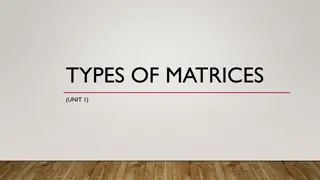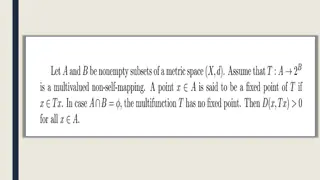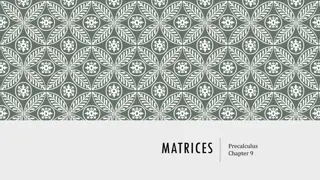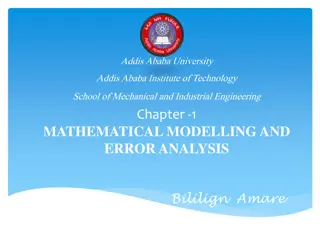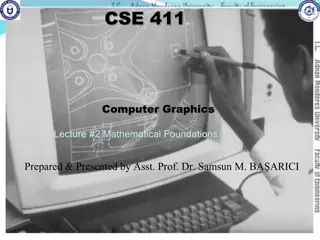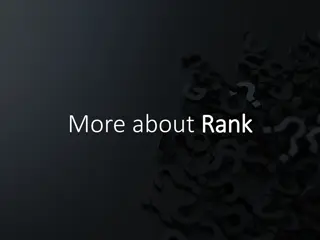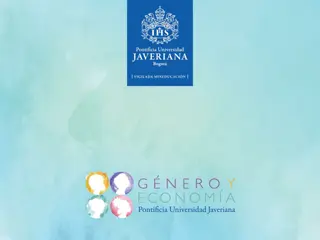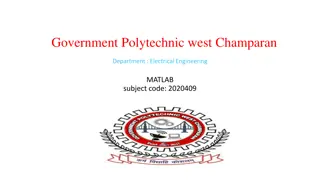Introduction to Matrices in Mathematical Analysis
Matrices play a crucial role in simplifying complex systems of equations and are well-suited for systematic mathematical treatments and computer computations. This introduction covers the definition of matrices, their properties such as size and notation, and various types of matrices including column, row, rectangular, and square matrices. Understand the basics of matrix algebra and its applications in mathematics and computer engineering.
Download Presentation

Please find below an Image/Link to download the presentation.
The content on the website is provided AS IS for your information and personal use only. It may not be sold, licensed, or shared on other websites without obtaining consent from the author.If you encounter any issues during the download, it is possible that the publisher has removed the file from their server.
You are allowed to download the files provided on this website for personal or commercial use, subject to the condition that they are used lawfully. All files are the property of their respective owners.
The content on the website is provided AS IS for your information and personal use only. It may not be sold, licensed, or shared on other websites without obtaining consent from the author.
E N D
Presentation Transcript
Mustansiriyah University College of Engineering Computer Engineering Dept Mathematical analysis II Matrices Introduction Lect. Sarmad K. Ibrahim
Matrices - Introduction Matrix algebra has at least two advantages: Reduces complicated systems of equations to simple expressions Adaptable to systematic method of mathematical treatment and well suited to computers Definition: A matrix is a set or group of numbers arranged in a square or rectangular array enclosed by two brackets 4 2 a b 1 1 3 0 c d
Matrices - Introduction Properties: A specified number of rows and a specified number of columns Two numbers (rows x columns) describe the dimensions or size of the matrix. Examples: 1 2 4 3x3 matrix 1 2 1 1 3 3 1 3 4 1 5 2x4 matrix 0 0 3 3 3 1x2 matrix
Matrices - Introduction A matrix is denoted by a bold capital letter and the elements within the matrix are denoted by lower case letters e.g. matrix [A] with elements aij a ... a a a a 11 12 ij in Amxn= mAn ... a a a 21 22 2 ij n a a a a 1 2 m m ij mn i goes from 1 to m j goes from 1 to n
Matrices - Introduction TYPES OF MATRICES 1. Column matrix or vector: The number of rows may be any integer but the number of columns is always 1 a 1 1 11 a 4 21 3 2 a 1 m
Matrices - Introduction TYPES OF MATRICES 2.Row matrix or vector Any number of columns but only one row 6 2 0 3 5 1 1 a a a a 11 12 13 1 n
Matrices - Introduction TYPES OF MATRICES 3. Rectangular matrix Contains more than one element and number of rows is not equal to the number of columns 1 1 1 1 1 0 0 3 7 2 0 3 3 0 7 7 7 6 m n
Matrices - Introduction TYPES OF MATRICES 4. Square matrix The number of rows is equal to the number of columns (a square matrix A has an order of m) m x m 1 1 1 1 1 9 9 0 3 0 6 6 1 The principal or main diagonal of a square matrix is composed of all elements aij for which i=j
Matrices - Introduction TYPES OF MATRICES 5. Diagonal matrix A square matrix where all the elements are zero except those on the main diagonal 3 0 0 0 1 0 0 0 3 0 0 0 2 0 0 0 5 0 0 0 1 0 0 0 9 i.e. aij =0 for all i = j aij = 0 for some or all i = j
Matrices - Introduction TYPES OF MATRICES 6. Unit or Identity matrix - I A diagonal matrix with ones on the main diagonal 0 0 1 0 1 0 0 0 1 0 0 a 0 ij 0 0 1 0 0 1 a ij 0 0 0 1 i.e. aij =0 for all i = j aij = 1 for some or all i = j
Matrices - Introduction TYPES OF MATRICES 7. Null (zero) matrix - 0 All elements in the matrix are zero 0 0 0 0 0 0 0 0 0 0 0 0 = 0 ij a For all i,j
Matrices - Introduction TYPES OF MATRICES 8. Triangular matrix A square matrix whose elements above or below the main diagonal are all zero 1 0 0 1 0 0 1 8 9 2 1 0 2 1 0 0 1 6 5 2 3 5 2 3 0 0 3
Matrices - Introduction TYPES OF MATRICES 8a. Upper triangular matrix A square matrix whose elements below the main diagonal are all zero 1 7 4 4 a 0 a a 1 8 7 ij ij ij 0 1 7 4 a 0 a 0 1 8 ij ij 0 0 7 8 0 a 0 0 3 ij 0 0 0 3 i.e. aij = 0 for all i > j
Matrices - Introduction TYPES OF MATRICES 8b. Lower triangular matrix A square matrix whose elements above the main diagonal are all zero ij ij a a a 0 0 a 1 0 0 ij 0 a a 2 1 0 5 2 3 ij ij ij i.e. aij = 0 for all i < j
Matrices Introduction TYPES OF MATRICES 9. Scalar matrix A diagonal matrix whose main diagonal elements are equal to the same scalar A scalar is defined as a single number or constant 6 0 0 0 1 0 0 0 0 a 0 ij 0 1 0 0 a 0 0 6 0 0 ij 0 0 1 0 a 0 0 6 0 ij 0 0 0 6 i.e. aij = 0 for all i = j aij = a for all i = j
Matrices Matrix Operations
Matrices - Operations EQUALITY OF MATRICES Two matrices are said to be equal only when all corresponding elements are equal Therefore their size or dimensions are equal as well 1 0 0 1 0 0 A = A = B B = 2 1 0 2 1 0 5 2 3 5 2 3
Matrices - Operations Some properties of equality: IIf A = B, then B = A for all A and B IIf A = B, and B = C, then A = C for all A, B and C 1 0 0 b b b 11 12 13 A = B = 2 1 0 b b b 21 22 23 5 2 3 b b b 31 32 33 a = b If A = B then ij ij
Matrices - Operations ADDITION AND SUBTRACTION OF MATRICES The sum or difference of two matrices, A and B of the same size yields a matrix C of the same size = + c a b ij ij ij Matrices of different sizes cannot be added or subtracted
Matrices - Operations Commutative Law: A + B = B + A Associative Law: A + (B + C) = (A + B) + C = A + B + C 6 7 3 1 1 5 6 8 8 5 + = 2 5 4 2 3 2 7 9 B C A 2x3 2x3 2x3
Matrices - Operations A + 0 = 0 + A = A A + (-A) = 0 (where A is the matrix composed of aij as elements) 6 4 2 1 2 0 5 2 2 = 3 2 7 1 0 8 2 2 1
Matrices - Operations SCALAR MULTIPLICATION OF MATRICES Matrices can be multiplied by a scalar (constant or single element) Let k be a scalar quantity; then kA = Ak 1 3 1 Ex. If k=4 and 2 = A 2 3 4 1
Matrices - Operations 1 1 3 1 3 1 12 4 2 2 8 4 = = 4 4 2 3 2 3 8 12 4 1 4 1 16 4 Properties: k (A + B) = kA + kB (k + g)A = kA + gA k(AB) = (kA)B = A(k)B k(gA) = (kg)A
Matrices - Operations MULTIPLICATION OF MATRICES The product of two matrices is another matrix Two matrices A and B must be conformable for multiplication to be possible i.e. the number of columns of A must equal the number of rows of B Example. A x B = C (1x3) (3x1) (1x1)
Matrices - Operations B x A = Not possible! (2x1) (4x2) A x B = Not possible! (6x2) (6x3) Example A x B = C (2x3) (3x2) (2x2)
Matrices - Operations b b 11 12 a a a c c 11 12 13 11 12 = b b 21 22 a a a c c 21 22 23 21 22 b b 31 32 + + = ( ) ( ) ( ) a b a b a b c 11 11 12 21 13 31 11 c + + = ( ) ( ) ( ) a b a b a b 11 12 12 22 13 32 12 + + = ( ) ( ) ( ) a b a b a b c 21 11 22 21 23 31 21 + + = ( ) ( ) ( ) a b a b a b c 21 12 22 22 23 32 22 Successive multiplication of row i of A with column j of B row by column multiplication
Matrices - Operations 4 8 + + + + 1 2 3 1 ( ) 4 2 ( ) 6 3 ( ) 5 1 ( ) 8 2 ( ) 2 3 ( ) 3 = 6 2 4 ( + + + + 4 2 7 ) 4 2 ( ) 6 7 ( ) 5 4 ( ) 8 2 ( ) 2 7 ( ) 3 5 3 31 21 = 63 57 Remember also: IA = A 1 0 31 21 31 21 = 0 1 63 57 63 57
Matrices - Operations Assuming that matrices A, B and C are conformable for the operations indicated, the following are true: 1. AI = IA = A 2. A(BC) = (AB)C = ABC - (associative law) 3. A(B+C) = AB + AC - (first distributive law) 4. (A+B)C = AC + BC - (second distributive law) Caution! 1. AB not generally equal to BA, BA may not be conformable 2. If AB = 0, neither A nor B necessarily = 0 3. If AB = AC, B not necessarily = C
Matrices - Operations AB not generally equal to BA, BA may not be conformable 1 2 = T 5 0 3 4 = S 2 0 2 1 3 4 3 8 = = TS 5 0 0 2 15 20 3 4 1 2 23 6 = = ST 0 2 5 0 10 0
Matrices - Operations If AB = 0, neither A nor B necessarily = 0 1 1 2 3 0 0 = 0 0 2 3 0 0
Matrices - Operations TRANSPOSE OF A MATRIX If : 2 4 7 = = 3 A 2A 5 3 1 2x3 Then transpose of A, denoted AT is: 2 5 T = = 3 T 4 3 A A 2 7 1 a = T ji a For all i and j ij
Matrices - Operations To transpose: Interchange rows and columns The dimensions of AT are the reverse of the dimensions of A 2 4 7 = = 3 A 2A 2 x 3 5 3 1 2 5 2 = = T T 4 3 A A 3 x 2 3 7 1
Matrices - Operations Properties of transposed matrices: 1. (A+B)T = AT + BT 2. (AB)T = BTAT 3. (kA)T = kAT 4. (AT)T = A
Matrices - Operations 1. (A+B)T = AT + BT 8 2 6 7 3 1 1 5 6 8 8 5 + = 8 7 2 5 4 2 3 2 7 9 5 9 7 2 1 4 8 2 + = 3 5 5 2 8 7 1 6 6 3 5 9
Matrices - Operations (AB)T = BTAT 1 1 1 0 2 = 1 2 8 0 2 3 8 2 1 0 8 = 1 1 2 1 2 2 0 3
Matrices - Operations SYMMETRIC MATRICES A Square matrix is symmetric if it is equal to its transpose: A = AT a b = A b b d a = T A b d
Matrices - Operations When the original matrix is square, transposition does not affect the elements of the main diagonal a b = A c c d a = T A b d The identity matrix, I, a diagonal matrix D, and a scalar matrix, K, are equal to their transpose since the diagonal is unaffected.
Matrices - Operations INVERSE OF A MATRIX Consider a scalar k. The inverse is the reciprocal or division of 1 by the scalar. Example: k=7 the inverse of k or k-1 = 1/k = 1/7 Division of matrices is not defined since there may be AB = AC while B = C Instead matrix inversion is used. The inverse of a square matrix, A, if it exists, is the unique matrix A-1 where: AA-1 = A-1A = I
Matrices - Operations Example: 3 1 = = 2 A A 2 2 1 3 1 1 = 1 A 2 Because: 3 1 1 3 1 1 0 = 2 2 1 0 1 3 3 1 1 1 1 0 = 2 1 2 0 1
Matrices - Operations Properties of the inverse: = 1 1 1 ( ) AB B A = 1 1 ( ) A A = 1 1 T T ( ) ( ) A A 1 k = 1 1 ( ) kA A A square matrix that has an inverse is called a nonsingular matrix A matrix that does not have an inverse is called a singular matrix Square matrices have inverses except when the determinant is zero When the determinant of a matrix is zero the matrix is singular
Matrices - Operations DETERMINANT OF A MATRIX To compute the inverse of a matrix, the determinant is required Each square matrix A has a unit scalar value called the determinant of A, denoted by det A or |A| 1 2 = A If 6 5 1 2 = then A 6 5
Matrices - Operations If A = [A] is a single element (1x1), then the determinant is defined as the value of the element Then |A| =det A = a11 If A is (n x n), its determinant may be defined in terms of order (n-1) or less.
Matrices - Operations MINORS If A is an n x n matrix and one row and one column are deleted, the resulting matrix is an (n-1) x (n-1) submatrix of A. The determinant of such a submatrix is called a minor of A and is designated by mij , where i and j correspond to the deleted row and column, respectively. mij is the minor of the element aij in A.
Matrices - Operations eg. a a a 11 12 13 = A a a a 21 22 23 a a a 31 32 33 Each element in A has a minor Delete first row and column from A . The determinant of the remaining 2 x 2 submatrix is the minor of a11 a m = a 22 23 11 a a 32 33
Matrices - Operations Therefore the minor of a12 is: a a 21 23 m = 12 a a 31 33 And the minor for a13 is: a a 21 22 m = 13 a a 31 32
Matrices - Operations COFACTORS The cofactor Cij of an element aij is defined as: C = ) 1 ( + i j m ij ij When the sum of a row number i and column j is even, cij = mij and when i+j is odd, cij =-mij ( ) 1 , 1 ( j i c = = = + = = = ) 1 = + 1 1 m m 11 11 11 m + ) 1 = 1 2 ( , 1 ) 2 ( c i j m 12 12 12 + = = = ) 1 = + 1 3 ( , 1 ) 3 ( c i j m m 13 13 13
Matrices - Operations DETERMINANTS CONTINUED The determinant of an n x n matrix A can now be defined as = = + + + det A A a c a c a nc 1 11 11 12 12 1 n The determinant of A is therefore the sum of the products of the elements of the first row of A and their corresponding cofactors. (It is possible to define |A| in terms of any other row or column but for simplicity, the first row only is used)
Matrices - Operations Therefore the 2 x 2 matrix : a a 11 12 = A a a 21 22 Has cofactors : = = = c m a a 11 11 22 22 And: = = = c m a a 12 12 21 21 And the determinant of A is: a A = + = c a c a a a a 11 11 12 12 11 22 12 21
Matrices - Operations Example 1: 3 1 = A ) 2 )( 1 2 1 ( = = 3 ( ) 1 )( 5 A
Matrices - Operations For a 3 x 3 matrix: = 22 21 a a a a a 11 12 13 A a a a 23 a 31 32 33 The cofactors of the first row are: a c = a 22 23 = a a a a 11 22 33 23 32 a a 32 a 33 a 21 23 = = ( ) c a a a a 12 21 33 23 31 a a 31 33 a a 21 22 = = c a a a a 13 21 32 22 31 a a 31 32



